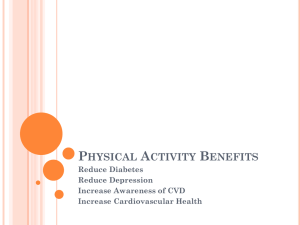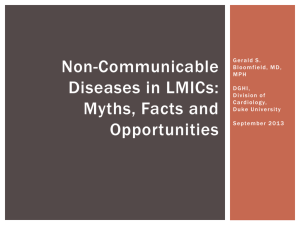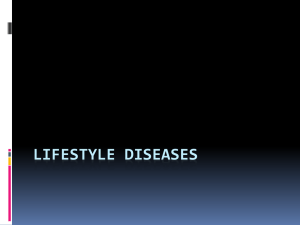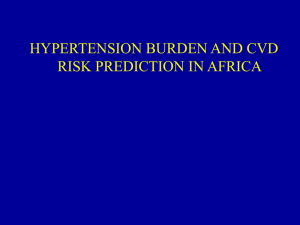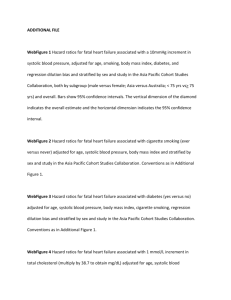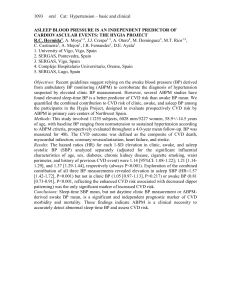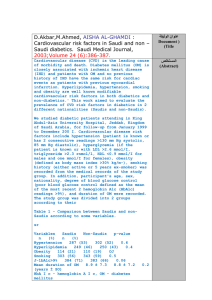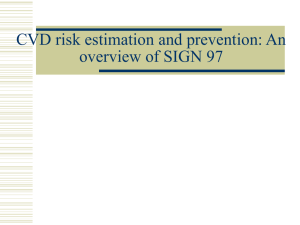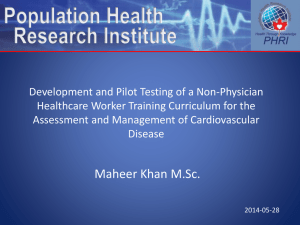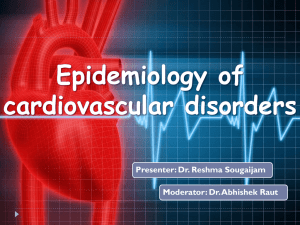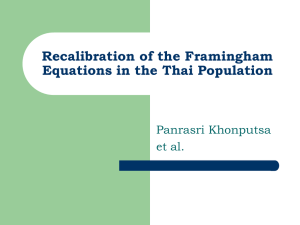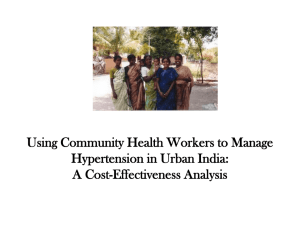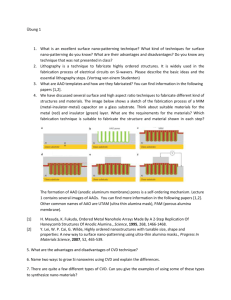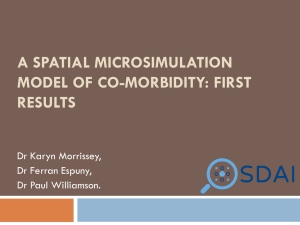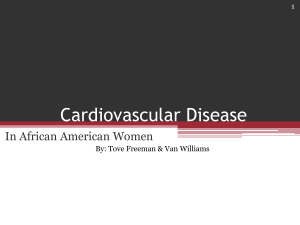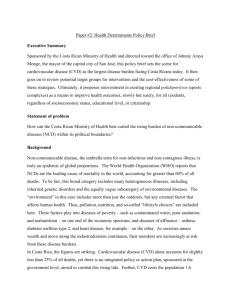Introduction to Indian Worksite Wellness Program (1)
advertisement
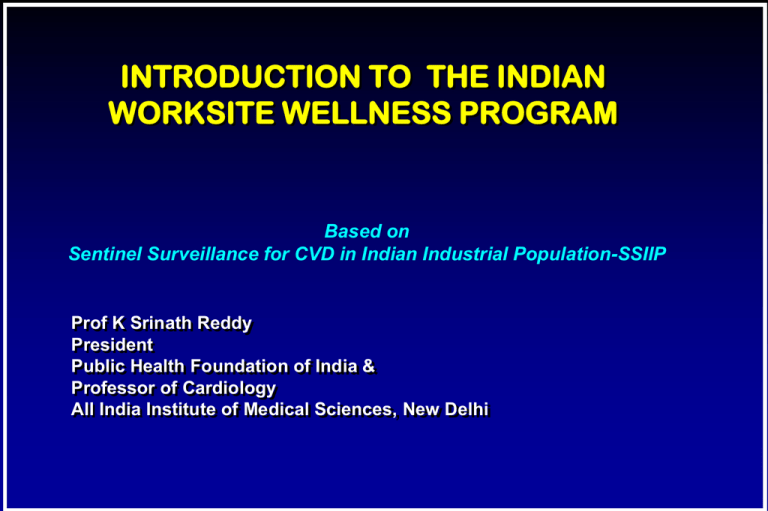
INTRODUCTION TO THE INDIAN WORKSITE WELLNESS PROGRAM Based on Sentinel Surveillance for CVD in Indian Industrial Population-SSIIP Prof K Srinath Reddy President Public Health Foundation of India & Professor of Cardiology All India Institute of Medical Sciences, New Delhi Deaths In India (2005) 7% CVD 2% Chronic resp. ds. 29% 11% Other chronic ds Communicable ds, perinatal, maternal conditions & nutritional deficiencies Injuries 7% 36% 8% Source : WHO Cancer Rising Chronic Disease Burdens 2007 2025 No. of Persons with HYPERTENSION 125 Million 214 Million No. of Persons with DIABETES 41 Million 69 Million + 1 Million 2 Million + No. of Persons Dying from TOBACCO Worksite Survey: Study Settings Ten large/ medium industries across India, employing 1500-5000 people (public & private) twinned to medical colleges (public & private) Employees and their family members Surveillance of CVD risk factors Age Group : 20-69 years (n=19973 for the questionnaire survey and n= 10442 for biochemical investigations). Worksite Wellness Programme Age adjusted prevalence of risk factors Graph 1: Age adjusted prevalence of CVD2002-2003 risk factors Men Women Prevalence % 60 50 40 45.8 48.1 30 30.3 20 40.2 40.2 35.0 34.4 25.5 26.0 10 26.3 15.5 8.3 9.0 18.4 0 Overweight Central Obesity Dyslipidemia Diabetes Hypertension Tobacco Use Risk factors KS Reddy et al WHO Bulletin 2006 Metabolic Syndrome COEXISTENCE OF MULTIPLE RISK FACTORS (SSIP 20-69 YRS) 120 97.8 Percentage 100 89.9 80 60.2 60 43.5 40 20 25.8 2.2 0 0 1 2 3 4 4 plus No of risk factors Age>50, Current regular use of tobacco, SBP>=120 to <140, PG 100-125.9 mg/dl, Tg>150 mg/dl, Tc/HDl >=4.5, HDL <40 (m)/HDL<50 (f) BMI>23, WC >80 (f), or WC>90 (m) and Family history of CVD CVD Risk Factor Survey in 10 Industries Risk Factors by Educational Status in Men Risk Factors ES I (%) OR Tobacco Use 19.8 1 Smoking 15.2 1 Regular Physical Activity ES II (%) OR ES III (%) OR ES IV (%) OR P for trend 40.2 2.7 (2.4-3.1) 77.3 13.8 (11.7-16.2) <0.001 16.7 1.1 (0.9-1.3) 24.4 1.8 (1.5-2.1) 21.8 1.5 (1.3-1.8) 0.04 41.6 1 40.0 0.9 (0.8-1.1) 34.7 0.7 (0.6-0.8) 13.2 0.2 (0.18-0.25) <0.001 Diabetes 8.4 1 10.4 1.2 (0.95-1.6) 13.3 1.6 (1.3-2.1) 7.6 0.9 (0.6-1.3) 0.056 Hypertension 27.2 1 29.9 1.1 (0.99-1.3) 28.6 1.1 (0.9-1.2) 32.6 1.3 (1.1-1.4) 0.05 26.5 1.4 (1.2-1.7) Metabolic Syndrome 19.2 20.9 20.6 24.9 0.05 1 1.1 (0.9-1.4) 1.1 (0.9-1.3) 1.3 (1.1-1.7) ES I: Post Graduate; ES II: Graduate; ES III: Secondary or High School; ES IV : Primary or Illiterate (Ongoing Indian Industrial Surveillance Study; Baseline Survey in 2002-03) YEARS OF LIFE LOST DUE TO CVD IN POPULATIONS AGED 35-64 YEARS 17.9 India 9.2 10.5 China 6.7 3.2 Russia 3.3 PPYLL IN 2030 PPYLL IN 2000 2 USA 1.6 0.4 0.3 S. Africa 0.05 Portugual 0.04 0 2 4 6 8 10 12 14 16 18 20 NUMBER IN MILLIONS PPYLL= Potentially Productive Years of Life Lost Health Promotion Component Health Interventions at other sites Population approach: Pamphlets, posters, health talks, health promos on visual medium, health melas, healthy cooking competitions, High Risk Approach: Individual counseling, group counseling, referral to medical doctor for management of hypertension, diabetes and dyslipidemia Environmental changes: Provided healthier alternatives at canteen, banned tobacco inside the premises etc Interventions were targeted to Create readiness to change Influence aspiration to change and espouse new behaviors Improve engagement of the individuals and the community-interaction, self-efficacy, relapses Change environmental barriers( work-site, educational inst., canteens, hotels, overcoming cost factors, availability) Eliminate environmental societal stimulants Introduce behavioral supports Worksite Wellness Programme Intermediate changes (2004-2005) Behavioral changes % changes Physical activity levels ↑ 17.1% Fruits and vegetable consumption ↑36.3% Conscious effort to decrease oil/ghee/butter consumption ↑ 31.3% Age adjusted prevalence of risk factors in females (before and after intervention) 60 50 48.1 40 30 28.5 30.3 17 20 Before 26.324.8 After 15.5 9 10 4.2 6 0 Overweight Central obesity Tobacco use Hypertension Diabetes Trends in mean levels of variables in Men (six centre data) Variable Baseline:2002 n=6428 First Annual Surveillance: 2004 n=1236 Final survey: 2006 n=4698 SBP 128.4 (16.7) 127.1 (16.8) 123.4 (16.7) DBP 79.9 (10.8) 78.4 (10.5) 74.7 (10.5) Weight 62.2 (12.6) 61.8 (12.3) 61.7 (11.8) WC 84.0 (11.1) 81.8 (11.0) 81.0 (10.3) PG 92.1 (29.0) n=2894 90.1 (30.5) n=1207 83.6 (31.8) n=4062 TC 176.5 (43.0) 173.1 (42.2) 165.7 (43.8) TG 132.9 (76.1) 132.0 (80.1) 135.5 (80.9) 43.2 (11.6) 45.8 (11.5) 49.5 (10.3) HDL Proportion of individuals above the Framingham 10 year CVD risk of >=10% 40 Percentage % 35 30 Baseline Final 34.7 34.1 26.8 25.4 25 20 15 10 5 0 Intervention Control PRIMARY PREVENTION OF CVD Risk Detection + Risk Reduction in Individuals People EDUCATION Professionals Self -Referral + Opportunistic Screening HBP, Overweight, Tobacco, Physical Inactivity, Diet, Age, Gender, Personal/Family History GUIDELINES Risk stratification (Step I) (Diagnostic Algorithms) Targeted Screening Diabetes, Dyslipidemia, Assessment for CVD GUIDELINES Risk Stratification (Step II) (Management Algorithms) Appropriate Therapy Lifestyle Measures + Drugs
